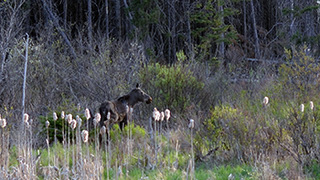
Moose: A moose stands in a wetland area alongside U.S. Highway 41 in Marquette County.
|
Motorists traveling in the Upper Peninsula are being urged to keep an eye out for moose and to exercise extra caution when driving after dark.
Over the past week, five bull moose have been struck and killed by vehicles along portions of M-95 and U.S Highways 141 and 41 West in Marquette and Baraga counties.
“All of the moose killed were struck after darkness fell, when moose, especially the darker colored bulls, are more difficult for motorists to see,” said John Pepin, Michigan Department of Natural Resources deputy public information officer. “Each of these accidents occurred in areas marked with ‘moose crossing’ signs.”
Specifically, three crashes occurred on June 10, two in Baraga County and one in Marquette County. The incidents in Baraga County were located a mile west of Nestoria on U.S. Highway 41 and 1.5 miles south of Covington on U.S. Highway 141. The mishap in Marquette County happened on M-95, a half-mile south of its intersection with U.S. Highway 41.
On June 13, two additional vehicle-moose accidents happened. One was in Baraga County on U.S. Highway 41 at the crossing of Tioga Creek, while the second occurred in Marquette County on M-95, 1.5 miles south of its intersection with U.S. Highway 41.
On May 27, a sixth bull moose was killed along U.S. Highway 41 in Baraga County, 1.5 miles east of Alberta.
“Many people driving in the U.P. see moose and many people stop to look and take pictures, especially during the summer travel season,” Pepin said. “Folks doing this need to remember to pull safely off onto the shoulder of the road, watch for passing traffic and keep a safe distance from these wild animals.”
DNR wildlife biologist Brian Roell said autumn, when moose are mating, is more commonly a time for moose to be traveling.
The most recent DNR moose survey, conducted prior to the coronavirus pandemic in February 2019, estimated 509 moose in the western U.P. The next survey is planned for 2024.
The moose population is estimated to grow at an average of about 2% each year. The western U.P. moose range covers about 1,400 square miles.
For more information on moose in Michigan, visit Michigan.gov/Moose
DNR COVID-19 RESPONSE: For details on affected DNR facilities and services, visit this webpage. Follow state actions and guidelines at Michigan.gov/Coronavirus.